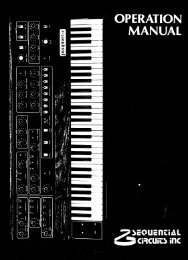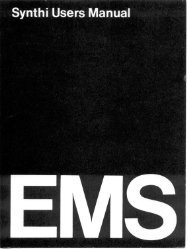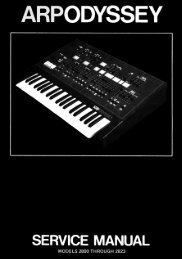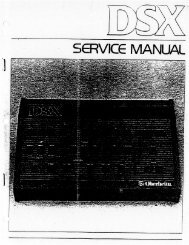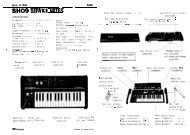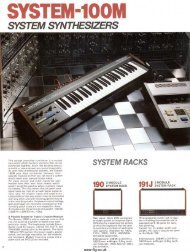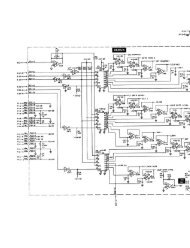SECTION THIRTEEN: KEYBOARD CONTROLS - 103The keyboard’s LFO is normalled into the patch <strong>of</strong> the keyboard’s CV. More accurately, the keyboard’sLFO actually adds vibrato to the keyboard control voltage itself. Thus, the voltage <strong>com</strong>ing into eachVCO via its normal to the keyboard CV actually fluctuates to create vibrato. This is an importantdesign concept. Because the vibrato is actually added to the keyboard CV signal before it reaches thecabinet, it is possible to use a newer keyboard such as the 3620 with an older cabinet. This is consideredto be a highly desirable <strong>com</strong>bination, since one can have the benefits <strong>of</strong> a duophonic keyboard and abuilt in LFO with delay while still retaining the older Moog filter design in the cabinet.THE LFO’S PARAMETERSThe keyboard’s LFO <strong>of</strong>fers four parameters. First, the rate and depth <strong>of</strong> the vibratocan be set. This is no different from the FM patch which was created in Section 3.The vibrato rate is adjusted using the LFO SPEED slider, while the vibrato depthis adjusted using the VIBRATO DEPTH slider. (See Figure 13-6) However, adelay can also be set for this vibrato. Delayed vibrato can be defined as the amount<strong>of</strong> time from the time a key is pressed to the time the vibrato starts in. It is adjustedusing the VIBRATO DELAY slider. (See Figure 13-6) This effect is highly desirablesince it better simulates real-world vibrato. Before this parameter was madeavailable on the keyboard’s LFO, synthesists would <strong>of</strong>ten route the output <strong>of</strong> theVCO being used as an LFO to an audio input on the VCA. The VCA would thenbe modulated by an EG and the output <strong>of</strong> the VCA would be fed back to the FMinputs on the VCOs. This patch is illustrated in Figure 13-7. In this patch, oneVCO, the VCA, and one EG are sacrificed to create delayed vibrato. A huge sacrifice,to be sure, but the effect was desirable enough to make it worthwhile formany synthesists.13-6: The keyboard’sLFO sectionVCOLF MODEEGSlow attacksimulates delayVCOVCAVCFEGFigure 13-7: Delayed vibrato without using the keyboard’s LFOToamplifierandspeakersNotice that the VCO in LFmode going to the VCA isa control but, since its amplitudeis actually beingchanged by the VCA, it isnot modulating the VCAitself. The EG modulating the VCAwill gradually increase the VCA’sgain, thus increasing the amount <strong>of</strong>the VCO in LF mode reaching theVCO that is being heard through theVCF. Again, the VCA is illustratedin yellow since it is a carrier whilebeing modulated by an EG and amodulator (the VCO’s signal exitingit to modulate the audio VCO).
104 - SECTION THIRTEEN: KEYBOARD CONTROLSWith the advent <strong>of</strong> the 3620 keyboard, synthesists could have their cake and eat it too! Delayed vibratocould be achieved without sacrificing a VCO, the VCA and an envelope generator. Delayed vibrato isa feature which can be found on almost every modern synthesizer.The final parameter <strong>of</strong> the keyboard’s LFO is its waveform. The keyboard LFO <strong>of</strong>fers users threedifferent waveforms, but the sine wave is the one which the LFO uses by default. One may recall fromSection 3 that sine waves are most <strong>com</strong>monly used for the purpose <strong>of</strong> creating vibrato. If one wants touse a waveform other than the sine wave, either the triangle or square waves can be used. However,these must be patched by hand to an FM input on each VCO. Separate outputs for each <strong>of</strong> the threewaveforms are available in the upper center part <strong>of</strong> the keyboard is control panel. It is interesting tonote that the ARP’s designers also felt that it was important to provide users with a way to add vibrat<strong>of</strong>rom an external source, such as an LFO on another synthesizer, or one <strong>of</strong> the 2600’s own VCOs. Thus,a fourth jack is provided (EXT VIBRATO IN) which allows a control signal to be input. This controlsignal is added to the keyboard’s CV and will be output to the VCOs in audio mode as vibrato.AM I REPEATING MYSELF?The 3620 has a nice little amenity built in called repeat. Repeat affects the way thekeyboard sends out trigger signals. When this three-position switch (see Figure 13-8) is in the center position, the keyboard will put out a trigger signal when onewould normally expect it to (more on this in a moment). When the repeat switch ismoved to the upper position, labeled KYBD, the keyboard will send out triggerpulse after trigger pulse as long as a key is being held down. When the switch is setFigure 13-8: Thetrigger mode andrepeat switchesto the lower AUTO setting, the keyboard will send out a stream <strong>of</strong> trigger pulsesregardless <strong>of</strong> whether a key is being played. Oddly enough, the rate at which thetrigger pulses are sent out is dictated by the keyboard’s LFO. This means that whenan external signal such as a square wave is input to the EXT VIBRATO IN jack, that signal will dictatethe rate at which the keyboard repeats. This is useful for synchronizing the repeat to other signals.The repeat feature lends itself to creating many special effects, but since the trigger signals are normalledto the EGs, one must remember to use the EGs to modulate something. For instance, the EGscould cause the VCA to function as a gate, thus causing a pulsing sound. Alternately, the EGs couldchange the pitch <strong>of</strong> the VCOs. Again, there are many possibilities available to the user here.TRIGGER MODEThe trigger mode switch allows the keyboard to function in what is sometimes referred to as legatomode. Legato is an Italian musical term which instructs players to play an attack only on the first notein a series <strong>of</strong> notes. By moving the TRIGGER MODE switch to SINGLE, the keyboard will only putout a trigger pulse when a key is played and no other keys are being played. For instance, if one playsand holds a C, the keyboard will send out a trigger pulse. If while holding the C, one plays another key,no additional trigger pulse will be sent out. While this is very musically useful, it takes a bit <strong>of</strong> gettingused to. This is particularly useful in creating the sounds one hears in older synthesizer solos. Earlysynthesizers (including early versions <strong>of</strong> the 2600’s keyboard) were stuck in single mode, and as such,




